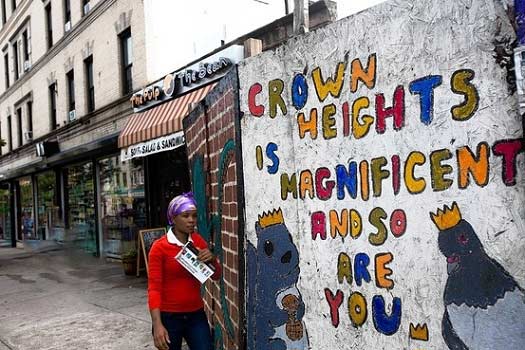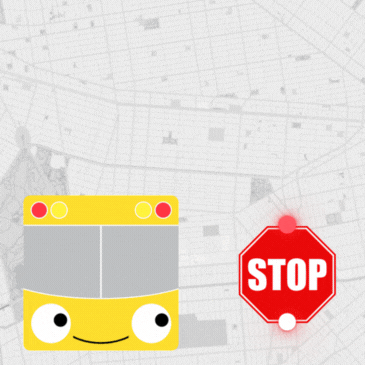
The New Crown Heights
The gentrification of Franklin Avenue in Crown Heights is most evident between Sterling and Park Place.
See it in Chavella’s, a recently relocated Mexican restaurant. It was filled with young hipsters on a rainy weekday afternoon. See it in the new Candy Rush store across the way, featuring Blue Marble ice-cream, $3.60 for a single scoop. At the Owl & Thistle General Store, you can buy yoga mats and “Brooklyn” onesies for your baby. A few storefronts down, there is clothing and antiques at Rosebud Vintage. An oyster bar is on its way.
This is the new Crown Heights.
But turn the corner onto Park Avenue and you’ll soon reach a stoop where a cluster of candles and a bouquet of white roses stand in memory of 56-year-old Denise Gay, a longtime resident who slumped to her death there on Monday.
This is the old storyline of Crown Heights, a neighborhood marred by violence and, inevitably, death.
The city experienced a burst of the bad old days over Labor Day weekend, and nowhere was the impact felt more strongly than this Brooklyn neighborhood, which experienced a string of shootings, some associated with the popular West Indian American Carnival Parade.
Ms. Gay’s block on Park Avenue is where the most sustained gunfire broke out, resulting in two deaths and two injured police officers. The episode raised questions about the delicate relationship between police and residents in a neighborhood in the midst of massive changes, and it called into question the parade itself, which has been associated with violence in the past.
On Wednesday, police admitted that the bullet that killed Ms. Gay could have been one of the 73 shots fired by their officers.
Some in the community had already reached that conclusion on their own.
“It was from the police,” said one resident and business owner who asked not to be identified, and who had expressed fears about the community’s reaction a day earlier. (“This is Crown Heights!” he remarked, evoking memories of the riots some 20 years before).
But by Thursday, the resident said, the situation appeared to have settled, though there was some anger. “People were kind of upset but it’s calm,” he said. “I don’t think it will get out of hand if the police admit that they engaged a gunman and shots were fired and one of their bullets hit an innocent bystander. That’s the right thing to do.”
That likely won’t happen. The police have indicated that they can’t conclusively say whose bullet killed Ms. Gay.
For some, the underlying problem is not who killed Ms. Gay, but that she died at all.
“It’s just tragic, whether the police shot her or one of the men who were fighting did. It’s a tragedy for the family, it’s a tragedy for the community,” said Lily Johnson-Dibia, owner of Lily & Fig, a bakery on Franklin Avenue, near Park Place.
Regardless, everyone has lost by the time residents and police are engaging in a gun battle, noted Nick Juravich, a 27-year-old who writes a blog, I Love Franklin Ave. “We can’t rely on the police alone to put an end to this,” he said, adding: “It’s hard to be optimistic right now. It was an ugly weekend for violence.”
The shootings were actually expected by some long-time residents of a neighborhood with a dark history of racial tension, drug dealing and violence.
“I’m surprised it took so long for this happen,” said Michael Jones, 53, sitting in Ja-Don’s salon on Franklin Avenue. “This usually happens more often.”
The difference, said he and another old-timer, Jimmie Monk, 72, is that nobody seemed to pay attention before.
“Years ago, you didn’t get people like you coming here,” said Mr. Monk.
He said he doesn’t mind the attention: “It’s a good thing, it’s change.”
Mr. Jones is less optimistic. He complains about the $12 burgers at a restaurant across the street, the rising rents and the police. He says the police treat the black and white populations differently—pointing to stop-and-frisk statistics that show mostly young black men are targeted—and blames that for any tension there is between the races.
“Right now, you don’t see any cops here,” Mr. Monk said. “Come back at 5, 6 p.m., and you will see all the cops. You wanna know why? Because all the white people are going home.”
“They’re here to protect the white people,” added Mr. Jones.
Newer transplants have their own complaints. In the past month, two women have complained of police doing surveillance on rooftops and telling the women they are not allowed to be there, despite having their landlord’s permission. On Saturday, Denise Posnak, a tenant on Prospect Place near Franklin, said about a dozen of her friends received summonses for open-container violations because they were drinking on the rooftop, what the police said was open space.
Police could not confirm the incident without additional information.
To be sure, there are many in the community who defend the police. Community groups have pushed for a strong police presence and lobbied to keep them there.
Assemblyman Hakeem Jeffries, whose district includes Crown Heights, said that in the past two decades the neighborhood has experienced “a dramatic decline in crime.”
It is because of this that the recent spate of violence—which he said began this summer—is so disconcerting.
“There are significant concerns in the community that we may experience the level of criminal activity that hasn’t been witnessed in a very long time in Crown Heights,” he said. “These episodes of violence are extremely unsettling. We want to make sure that we never go back to the days of old.”
To that end, on Thursday evening local police, elected officials and the Crow Hill Community Association were expected to gather at the corner of Franklin and Park Place and join forces to unite the community against violence.
Most of the residents I spoke with—new and longtime, black and white, young and old, unemployed and professional—said they intended to attend.













Tension
I don’t get it. What racial tension are these people talking about. As far as I am aware, all the gun activity that happened this past weekend had nothing to do with racial tension. It’s the same people attacking their own people.
I got it
So then I’ll explain it to you no. 1. The media tries to create the tension, because without tension people don’t want to read the story.
Culture of Violence
There is a big problem when violence like that happens, at at that scale it’s pretty horrible. Even though it could be said it was not our community, it affects everyone. I stayed inside all day after reading online that morning about 10 or so shootings the day and night before. That is rediculous. And I should probably just move out of the neighborhood… I still don’t think it’s a racial problem per say, unless it is one race against the other, for the most part it’s a problem that the violence and whatever specific factors are allowing a culture like that to perpetuate.